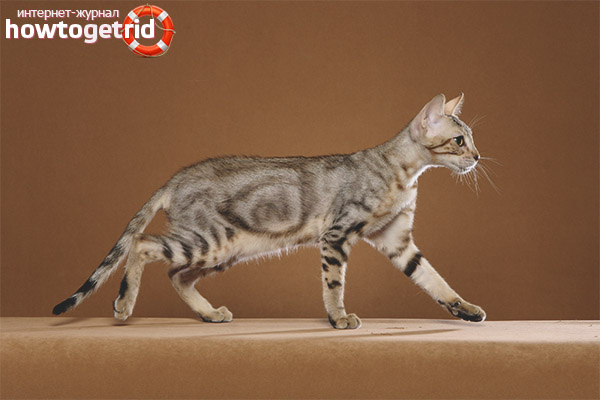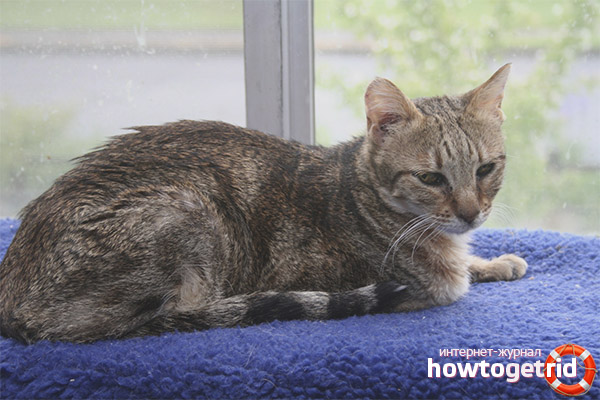The content of the article
Sokoke is a cat breed, the ancestors of which are Kenny's forest cats. Aborigines living in Africa call representatives of this breed of Hadzonzo. This breed is noted as one of those that was bred by nature, and not by breeders. Due to the fact that people did not intervene in their development, Sokoke are unique representatives in their area. Their homeland is the Sokoke region, which is located in one of the African countries - Kenya. Specific features of the animal are all that remain after natural selection, and not after the intervention of the breeder. Because of this, cats of this breed have become interesting to humans.
The history of the origin of cats Sokoke
Back in the late 80s of the last century, the first kittens were found in a coconut grove, by one local woman. They were wild, but she really liked their colors, so she took a couple of kittens to her home. After some time, when the cats had offspring, the woman offered kittens of this breed to her friend from Denmark. In turn, a friend also began to breed kittens, and carry them around Denmark and Italy.
After 20 years, another local woman in Kenya decided to investigate this breed of cats, and began to breed them. Many of the representatives of this line traveled to Europe, as well as to the United States of America.
Not so long ago, in order to understand the origin of cats sokoke, experts conducted research. Their results showed that they have common DNA with the feline Lamu Island representatives, and most surprisingly, their DNA is similar to ordinary spotted cats walking along the streets of eastern Kenya. And now all these representatives are assigned to one category, which is called the Arabian Sea. The result of their DNA is a combination of wild Arabian feline representatives, with Asian domestic.
Breed description
Representatives of Sokoke have average sizes for cats, but still they are slightly larger than them.
They have well-developed muscles, quite athletic. But this does not prevent them from being elegant and graceful at the same time. The average weight of an adult cat does not exceed 5 kilograms.
Sokoke standards and distinctive features regarding TICA:
- The cat's head has a modified wedge-shaped, slightly elongated, narrow. Compared to the body, the head seems small. Its upper part is flat, rather expressive cheekbones with a chin.
- Regarding the ears: they are mainly large and wide, sometimes there are brushes on the ends.
- The eyes of cats are expressive, set wide apart, almond-shaped. Their color is richly amber, they are also slightly greenish.
- The nose is quite wide, medium length, on the nose of the cat there is a slight bend.
- The body of the cat is long, but not flat, the chest is quite expressive, and the sides are rounded. Despite the slenderness, the juice body is quite muscular. This can be seen by paying attention to the cat’s neck and shoulders.
- The hind legs are slightly longer than the front, but both are rather slender and long. Due to the hind legs, it seems from the side that the cat is tiptoeing.
- The tail can be both long and medium in length, just like a muscular body, it has a narrowing towards the end.
- If we talk about sokok wool, then it is short, a little harsh, with almost no undercoat.
Cat color
Due to the fact that the juice is the descendants of wild cats, their colors may vary. It can be a variety of shades of brown. In all representatives of this breed, the hair is ticked, even on the tail.
The main differences between Sokoke cats are ticking and the presence of a color in the form of a marble tabby. The color of these cats has characteristic features:
- A continuous strip or several that wraps around the neck of a cat is also called a necklace.
- On the back of the animal there is a pattern that resembles a butterfly, it doesn’t matter if the lines are solid or broken.
- A pattern in the form of the letter “M” is marked on the forehead of the dismount, the line can also be broken.
Animal character
To determine whether the juice is suitable for a specific host, it is worthwhile to understand that such cats have increased activity. Thus, their wild roots make themselves known. In addition, the seals of this breed are very sociable and playful. Even if the owner is not at home, they will always find something to do. If a person is accustomed to the fact that cats should be lazy, or this is the first experience in a pet’s establishment, the juice may seem to them a hyperactive animal, which can negatively affect their relationship. After all, these cats love to climb everywhere, and touch everything that comes across to them.
But, despite this, these animals tend to become attached to their master, as well as to their own kind. It is very difficult for them to survive temporary partings with the owner, what to speak of new owners. These are not ordinary cats who like to lie on their hands, or require affection. Their affection is expressed in the fact that they go everywhere for their master.
This breed is considered an excellent option for those who have children. Sokoki cats are very tolerant, and not aggressive, and love to play.
Health juice
Due to the fact that these cats have African roots, they do not tolerate low temperatures very well. Although they can get used to over time. Sokoki cats, as shown by observations, are hypersensitive to atypical diseases for the country where they come from. To avoid problems, you need to keep them at home, and in no case do not allow contact with street cats and other breeds.
It has been observed that cats of this breed have a tendency to nerve disorders, meningitis, and also seizures. It is worth noting that these diseases are not only acquired, but also inherited. This is an excuse not to get an animal by hand.
Sokoke cats live on average 15 years. And puberty in them occurs by 8 or 10 months of life. When kittens are born in a cat, the papa cat, if he lives in a family, takes part in raising children.
Care
Caring for juice does not require special tricks. Bathing cats to produce once a month. This will not be a tragedy for them, because many of them are positive about water, and can swim.
For feeding, use a better balanced feed, or natural food. It is worth noting that the animal should receive enough taurine and vitamin E. This is necessary so that the metabolism goes better, and the heart system is strengthened.
The cost of a kitten sokoke
Despite the rarity of this breed, nevertheless, if desired, it can be found, but only the cost of a representative of this breed is quite high.
The average cost of an animal reaches 60 thousand in rubles. You can find a kitten for 30 thousand. Price depends on gender, and on compliance with breed standards. There are options for 100 thousand. It also depends on the country in which the potential buyer is located. There are countries where there is not a single nursery with this breed, so many are willing to pay a lot of money just to get a valuable representative sokoke.
Video: Sokoke cat breed












Submit